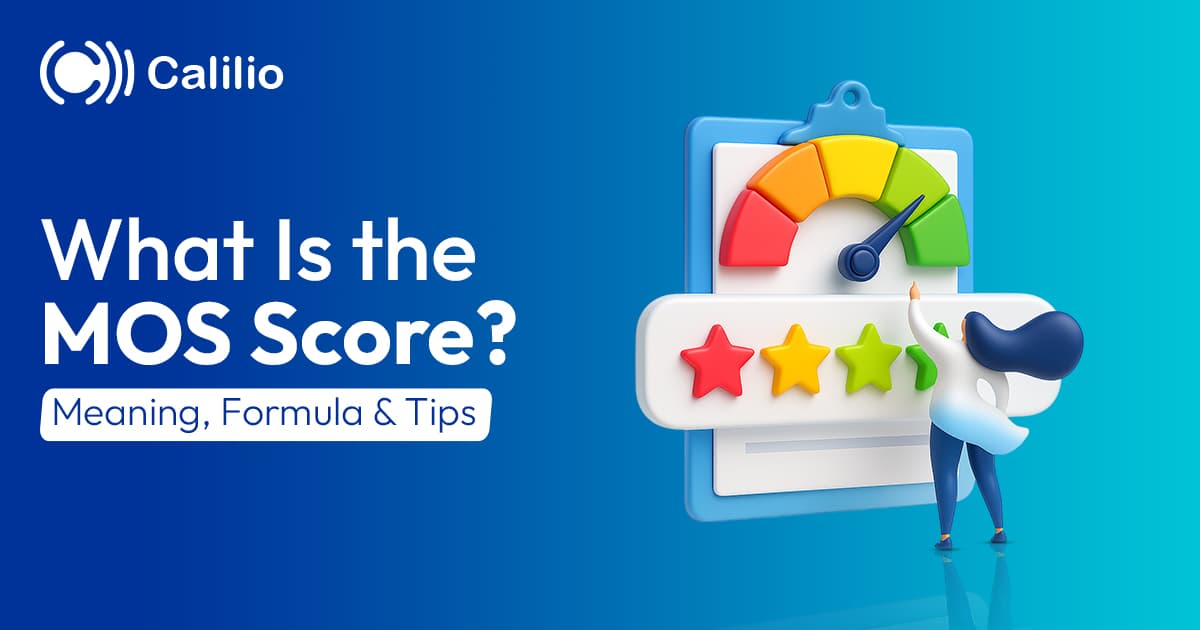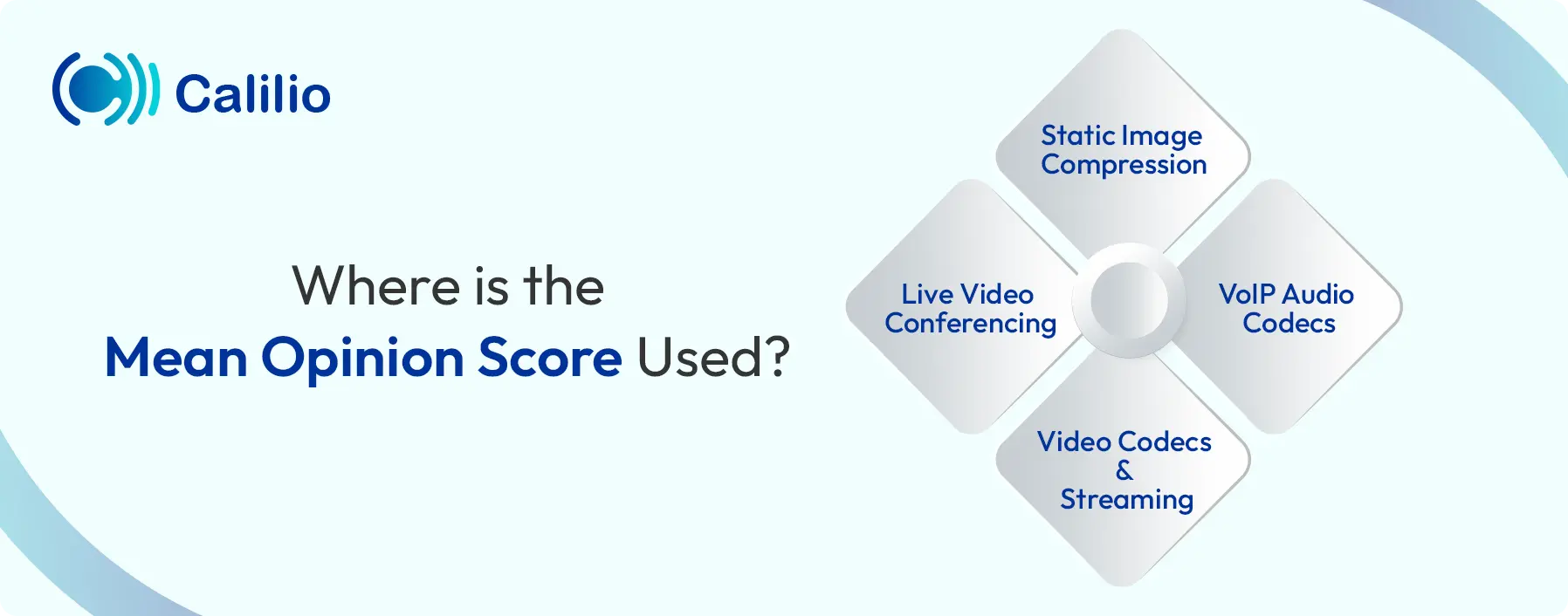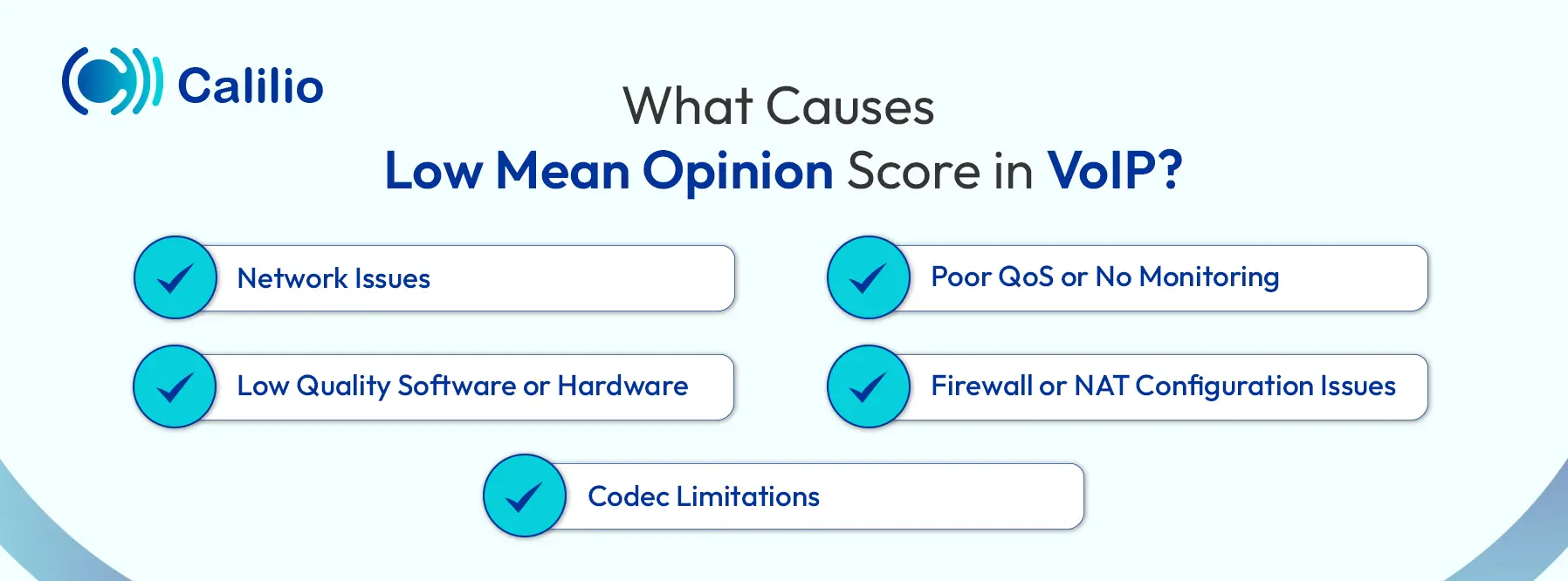What is the MOS Score? How to Calculate MOS in VoIP?

Poor call quality can damage your business more than you realize. Choppy audio, delays, robotic voices, or even a few seconds of bad communication can frustrate customers, hurt your brand, and lower team productivity. That’s why it’s essential to measure your voice call quality on a regular basis.
That’s where the MOS score comes in — the industry standard for evaluating VoIP audio quality. It helps you understand how good (or bad) your calls sound to users.
In this guide, you’ll learn what the MOS score is, how it’s calculated in VoIP systems, what impacts it, and how to maintain a high score for better business calls.
Key Highlights:
MOS (Mean Opinion Score) rates VoIP call quality on a scale from 1 to 5.
MOS objectively measures how users perceive voice quality, using either human feedback or automated testing.
A good MOS score for VoIP is typically above 4.0, with 4.3+ considered excellent.
Low MOS scores are caused by unstable networks, poor QoS settings, outdated hardware, misconfigured firewalls, and low-quality codecs.
You can improve MOS by stabilizing your network, enabling QoS VoIP settings, monitoring call quality in real time, and using better codecs and devices.
What is a MOS Score?
MOS (Mean Opinion Score) is a numerical rating from 1 (poor quality) to 5 (excellent quality) that measures the quality of voice calls in telecommunication systems, especially VoIP (Voice over Internet Protocol). It reflects how a human listener perceives the clarity, naturalness, and overall experience of a voice call.
Originally developed by the International Telecommunication Union (ITU), MOS was based on real human feedback where listeners rated audio samples. Today, MOS scores are often generated using algorithms that simulate human perception by analyzing factors like latency, jitter, and packet loss.
Experience Crystal-Clear VoIP calls with Calilio!
Where is the Mean Opinion Score Used?
A MOS can be used in various digital communication technologies where audio and video quality impact user experience. From static media, VoIP audios, and streaming platforms to video calls, MOS helps evaluate how clearly content is delivered and perceived by users. Below are the key areas where MOS scoring plays a vital role:
Below are the key areas where MOS scoring plays a vital role:
- Static Image Compression: MOS can measure how image quality changes after compression. It helps ensure that reduced file sizes don’t significantly affect how clear or sharp the image appears to viewers.
- VoIP Audio Codecs: VoIP systems use the MOS score to test how well different audio codecs (like G.711, G.729, or Opus) preserve voice clarity. A higher MOS indicates better VoIP call quality and recordings.
- Video Codecs and Streaming: Streaming platforms use MOS to assess video quality during playback. It reflects how users perceive visual clarity, resolution, and smoothness, especially during fast motion or low bandwidth.
- Live Video Conferencing: MOS is key to rating the quality of real-time video meetings. It combines voice and video scoring to ensure participants enjoy clear, synchronized, and interruption-free communication.
Why Calculate MOS in a VoIP System? Key Benefits
Calculating the MOS gives businesses a clear and consistent way to measure the actual quality of VoIP calls. Instead of relying on vague descriptions like “choppy audio” or “robot voice,” MOS provides a quantifiable score from 1 to 5, helping teams assess performance more accurately.
Here’s why calculating MOS is valuable for VoIP systems:
- Objective Voice Quality Measurement: MOS replaces guesswork with standardized scoring, making it easier to evaluate user experience.
- Real-time Call Monitoring: Monitoring MOS in real time helps detect drops in call quality as soon as they occur.
- Faster Issue Detection and Resolution: A sudden dip in MOS can alert IT teams to network problems and signal an instant resolution.
- Service Level Assurance: MOS helps providers maintain SLA targets by regularly assessing voice quality.
How to Calculate MOS Score in VoIP?
The MOS score in VoIP is calculated using either subjective testing (human feedback) or objective algorithms that simulate human perception. The traditional method, defined by the ITU, involves asking listeners to rate call quality on a scale from 1 (bad) to 5 (excellent) and then averaging their responses.
In modern VoIP systems, MOS is calculated automatically using network performance metrics such as latency, jitter, and packet loss.
The simplified formula for calculating MOS in VoIP is often derived from the E-model, expressed as:
MOS = 1 + 0.035R + 7 x 10⁻⁶R(R-60)(100-R)
Where R (the Transmission Rating Factor) is influenced by:
- Delay (latency) - Time taken for voice packets to travel.
- Jitter - Variation in packet arrival times.
- Packet Loss - Missing or dropped voice packets.
- Codec Performance - The efficiency of the audio compression algorithm.
What is a Good MOS Score for VoIP?
In VoIP, a good MOS score typically falls between 4.0 and 4.5, where users experience a clear, natural-sounding voice with minimal distortion or delay. A score above 4.5 is considered excellent, indicating near-perfect voice quality.
Here’s a quick breakdown of MOS score ranges and what they mean for VoIP call quality:
MOS Score | Quality Level | User Experience |
| 4.3 – 5.0 | Excellent | Crystal-clear audio, no issues |
| 4.0 – 4.3 | Good | Clear voice, very minor flaws |
| 3.6 – 4.0 | Fair | Slight distortion, still understandable |
| 3.1 – 3.6 | Poor | Noticeable issues affect conversation |
| 1.0 – 3.1 | Bad | Hard to hear, disruptive call quality |
While a perfect 5.0 is rarely achieved in real-world conditions, maintaining a score above 4.0 ensures a positive user experience. VoIP providers and IT teams often aim for this range to meet service-level standards and keep customer satisfaction high.
What Causes Low Mean Opinion Score in VoIP?
A low MOS score is usually caused by issues like network instability, poor QoS settings, or low-quality software and hardware. Additionally, misconfigured firewalls or NAT devices that block or delay voice packets, along with inefficient codecs that overly compress audio, can also result in choppy or unclear calls.

Network Issues
Network problems are the most common reason behind low MOS scores. When voice packets arrive late, out of order, or don’t arrive at all, the audio becomes distorted or delayed. Poor Wi-Fi, overloaded networks, or insufficient bandwidth often trigger these issues.
Poor QoS (Quality of Service) or No Monitoring
If you don’t actively monitor your VoIP traffic or configure QoS VoIP settings on your network, voice data can be delayed or deprioritized—especially when competing with other apps like video streaming or file transfers. Without proper monitoring tools, issues go undetected and continue to affect call quality over time.
Low Quality Software or Hardware
Using outdated or low-performance equipment can also lead to poor MOS scores. Inexpensive VoIP phones, low-end headsets, or unoptimized softphone apps can introduce audio distortion, delays, or echo. Similarly, VoIP systems running on outdated firmware may struggle to handle modern audio codecs or features, impacting voice clarity.
Firewall or NAT Configuration Issues
Improper firewall or NAT settings can block or delay VoIP traffic, leading to dropped packets or failed audio transmission. If voice packets can’t flow freely between endpoints, it will directly affect call quality and lower the MOS score.
Codec Limitations
Codec performance plays a key role in how natural and clear your calls sound. VoIP codecs are responsible for compressing and decompressing voice data. If your system uses low-quality or outdated codecs, the audio may sound robotic or compressed.
How to Improve VoIP MOS Score Results?
To improve your VoIP MOS score, optimize the technical factors that directly impact call quality, such as network performance, hardware, and codec selection. Also, regularly monitor call quality to identify and resolve issues before they affect user experience.
Monitor Call Quality in Real Time
Real-time monitoring tools VoIPmonitor, SolarWinds VoIP & Network Quality Manager, and PRTG Network Monitor can track MOS scores, detect sudden drops in quality, and identify issues like jitter or delay as they happen. Using these tools helps your IT team respond quickly, troubleshoot problems effectively, and maintain consistent call performance across your VoIP system.
Improve Network Stability
A stable internet connection with low latency and minimal packet loss is crucial for good VoIP performance. Use wired Ethernet instead of Wi-Fi when possible and ensure sufficient bandwidth is available for all active users. Investing in enterprise-grade routers or switches also helps reduce VoIP latency and manage voice traffic more efficiently, especially during peak hours.
Update Devices and Firmware
VoIP phones, routers, headsets, and softphone applications should always run on the latest firmware or software versions. Regular updates ensure better compatibility with modern codecs and improve audio processing.
Separate Voice and Data Networks
Sharing the same network for VoIP and general data traffic (like video conferencing, file transfers, or cloud applications) can cause congestion, leading to delayed or lost voice packets. To avoid this, consider setting up a separate VLAN (Virtual Local Area Network) for VoIP traffic. This ensures voice packets are transmitted without delay or interference.
Choose the Right VoIP Codec
While some codecs are optimized for high quality (like G.711), many are designed for bandwidth efficiency (like G.729). If your network has enough capacity, opt for high-fidelity codecs like Opus or G.711, which deliver clearer, more natural-sounding voice. The right codec balances bandwidth efficiency with audio quality, leading to higher MOS scores even in varying network conditions.
Wrapping Up
The Mean Opinion Score is a reliable and standardized way to measure VoIP call quality from the user’s perspective. By understanding what affects MOS, such as network stability, QoS settings, codecs, and hardware, you can take the right steps to improve voice clarity and ensure smooth communication.
A good MOS score helps reduce dropped calls, eliminate voice distortion, and build stronger customer relationships through professional, reliable conversations. But to consistently achieve high scores, the VoIP phone system you use also plays a critical role.
A platform like Calilio is built with robust network infrastructure and intelligent call routing, ensuring minimal call drops, fewer disruptions, and consistently clear audio. This makes it easier for businesses to maintain high MOS scores without constantly troubleshooting.
Frequently Asked Questions
What is an acceptable MOS score for VoIP?
An acceptable MOS score for VoIP is typically above 4.0, indicating clear and natural-sounding voice quality. Scores between 4.0 and 4.5 are considered good, while anything above 4.5 is excellent, but rarely achievable without optimal network conditions.
What affects your VoIP MOS test score?

Still have questions?
Can’t find the answer you’re looking for? Please chat with our friendly team.
Stay in the loop
Get the latest call insights, trends, and updates delivered straight to your inbox.
By subscribing, you agree to receive updates from Calilio.
You can unsubscribe anytime.
Phone numbers
Get International Phone Numbers
Singapore
|Australia
|New Zealand

